Nakhon Nayok is home to various birds, making it an excellent destination for birdwatchers. This lush province is home to multiple habitats, including forests, wetlands, and coastal areas, which provide a rich variety of bird species.
From large raptors to small waders, there is something for everyone here. With its diverse landscape, Nakhon Nayok is an ideal spot to observe all sorts of birds in their natural habitat.
From the majestic White-bellied Sea Eagle to the tiny Asian Brown Flycatcher, plenty of bird species keep visitors entertained.
17 Birds to Watch in Nakhon Nayok
Nakhon Nayok is a province in central Thailand that is known for its natural beauty and rich history. It is a popular destination for nature lovers, as it offers many opportunities to explore the surrounding forests, waterfalls, rivers, and mountains.
Here are 17 birds you should look out for when visiting Nakhon Nayok.
1. White-breasted Waterhen
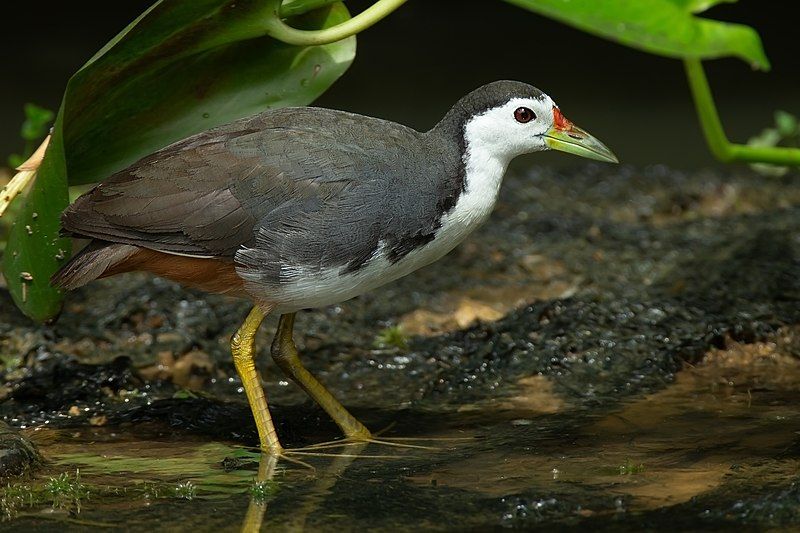
The white-breasted waterhen is a waterbird part of the Rallidae family, including rails and crakes. It can be found in many South and Southeast Asian regions and is easily identifiable by its dark, slaty feathers and clean white face, breast, and belly.
These birds are often found in wetlands, where they feed on small invertebrates and vegetation. They tend to be solitary birds but can be seen in pairs during breeding.
During this time, they can be seen engaging in courtship displays, such as displaying their white-breasted plumage and clucking. They nest in shallow cup-like nests made of grass and twigs; the female usually lays between four to six eggs.
The chicks are born precocial, meaning they can walk and feed themselves shortly after hatching.
The white-breasted waterhen is an essential species in the ecosystem, providing food for predators such as owls and significant control of the aquatic invertebrate populations.
| Kingdom | Animalia |
| Phylum | Chordata |
| Class | Aves |
| Order | Gruiformes |
| Family | Rallidae |
| Genus | Amaurornis |
| Species | A. phoenicurus |
2. Spotted Dove
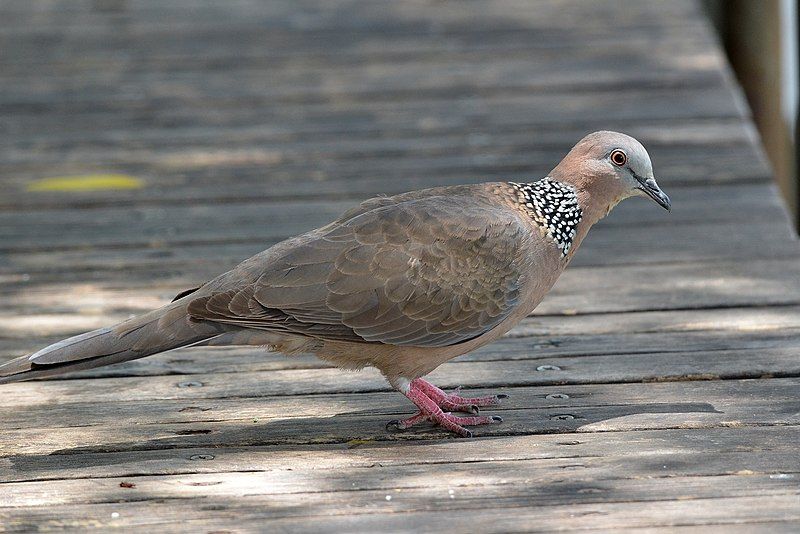
The spotted dove is a small, long-tailed pigeon found in many countries across the Indian subcontinent and Southeast Asia. It is a common resident breeding bird in its native range known for its ability to adapt to different habitats.
Due to this, the species has been introduced to many parts of the world. In some places, the dove has even established itself as a feral population.
This means that the species has been able to survive in the introduced area and has been able to produce offspring that can also survive in the new environment. This is a remarkable feat for a bird not native to the region.
The spotted dove is an adaptable species that has expanded its range and thrived in many different locations.
| Kingdom | Animalia |
| Phylum | Chordata |
| Class | Aves |
| Order | Columbiformes |
| Family | Columbidae |
| Genus | Spilopelia |
| Species | S. chinensis |
3. Lesser Whistling Duck
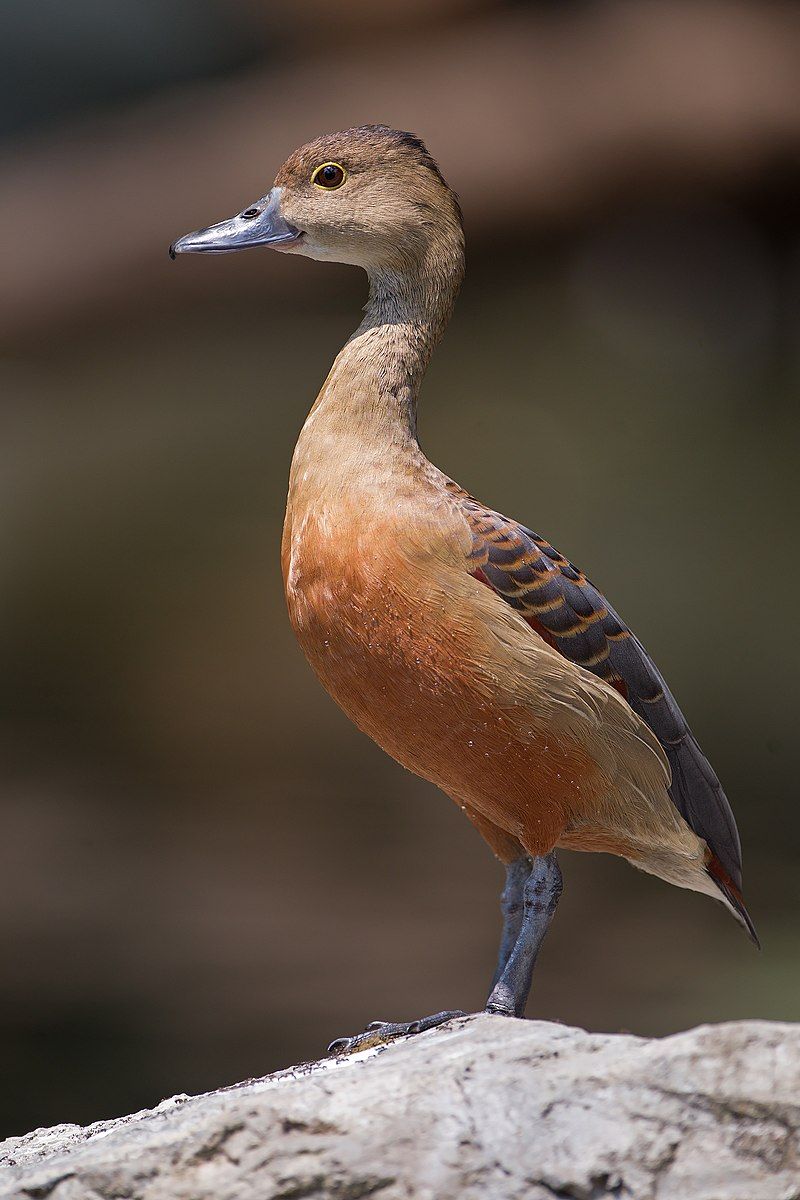
The lesser whistling duck, also known as Indian whistling duck or lesser whistling teal, is a species of waterfowl in the Indian subcontinent and Southeast Asia.
This species of duck is easily identified by its distinctive whistling call, which is the source of its name. The lesser whistling duck is a nocturnal feeder, meaning it forages for food at night and seeks shelter during the day.
During the day, these ducks may be found in large flocks, usually close to a body of water such as a lake or wet paddy fields.
These ducks feed on various aquatic plants, insects, and small fish. The lesser whistling duck is a widespread duck species among bird watchers and hunters. They are known for their small size and beautiful plumage, which can be seen from a distance.
They are also known for their social behavior and ability to form large flocks. Overall, the lesser whistling duck is a unique and exciting species worth learning about.
They are common in the Indian subcontinent and Southeast Asia and can be seen in large flocks around lakes and wet paddy fields. These ducks make for an enjoyable and memorable experience with their distinctive whistling call and social behavior.
| Kingdom | Animalia |
| Phylum | Chordata |
| Class | Aves |
| Order | Anseriformes |
| Family | Anatidae |
| Genus | Dendrocygna |
| Species | D. javanica |
4. Black-winged Stilt
The black-winged stilt is an aquatic wading bird from the avocet and stilt family. It is widely distributed globally and is highly recognizable due to its long legs. The scientific name for the species is H. himantopus.
It is sometimes considered a single, almost universally found bird species. Its body is primarily white, with black wings and tail feathers. Its beak is black and long, and its legs are bright red.
The black-winged stilt prefers shallow waters and is often found in wetlands, marshes, and swamps. It feeds on aquatic insects, crustaceans, and mollusks. The black-winged stilt is a reasonably social bird usually seen in large groups.
During the breeding season, pairs form and nest in shallow waters. The female lays two to four eggs at a time, and the male helps to incubate them. The young fledge in about a month. The black-winged stilt is a unique and fascinating bird species.
Its wide range and cosmopolitan status make it a widely appreciated species. It is common in wetlands and other aquatic habitats and has adapted well to human disturbance.
It is an essential species for the health of its habitat and is a valuable indicator of wetland health.
| Kingdom | Animalia |
| Phylum | Chordata |
| Class | Aves |
| Order | Charadriiformes |
| Family | Recurvirostridae |
| Genus | Himantopus |
| Species | H. himantopus |
5. Green Imperial Pigeon
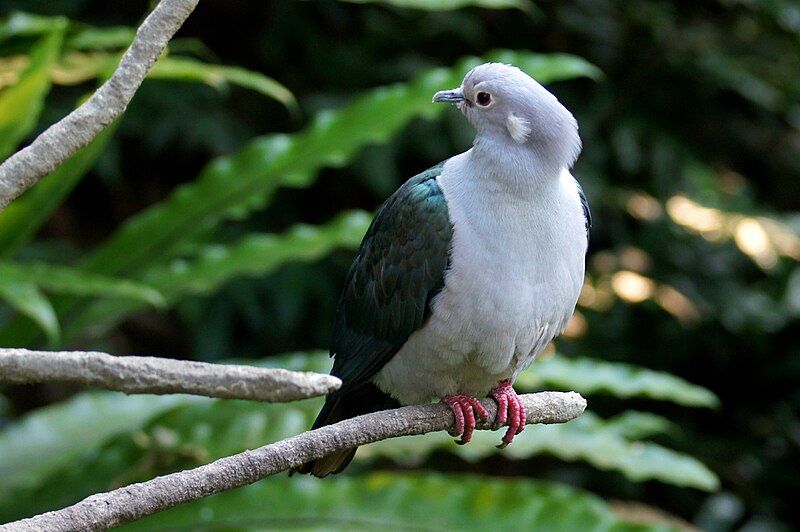
The green imperial pigeon is a large forest pigeon found across a wide area of Asia. It is native to Nepal, southern India, and Sri Lanka and can also be found in south China, Indonesia, and the Philippines.
This species is known for its impressive size, as it can grow up to 18 inches in length. It has a mostly green plumage, a yellowish wash on its neck, and a distinctive yellow eye-ring.
The green imperial pigeon is an arboreal species that spends most of its time in the treetops of tropical forests. It feeds mainly on fruits, seeds, flowers, and some insects. It is a gregarious species found in large flocks in its natural habitat.
| Kingdom | Animalia |
| Phylum | Chordata |
| Class | Aves |
| Order | Columbiformes |
| Family | Columbidae |
| Genus | Ducula |
| Species | D. aenea |
6. Great Egret
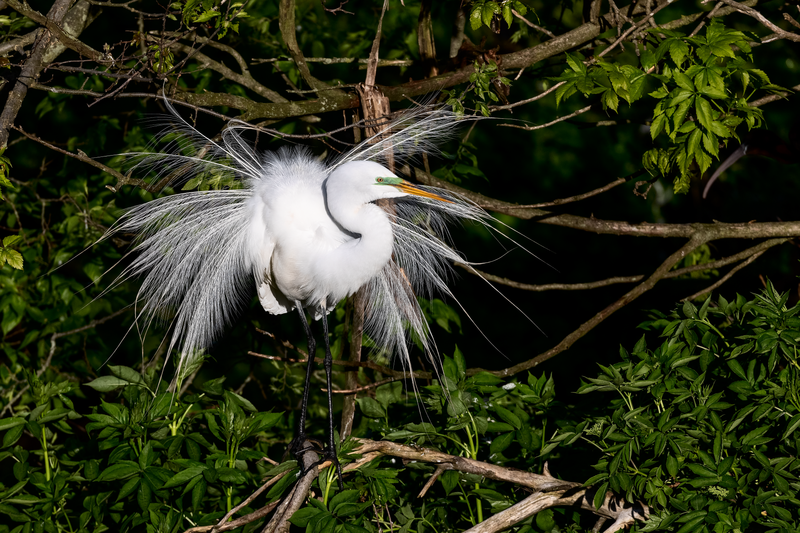
The great egret is a large, widely distributed species in many parts of the world. It is also known as the common egret, large egret, great white egret, or great white heron.
Four subspecies of the great egret are found in Asia, Africa, the Americas, and southern Europe. In recent years, it has been observed that the great egret is spreading into more northern areas of Europe, suggesting that the species may be expanding its range.
The great egret has white plumage and long, yellow legs. It feeds on fish, frogs, small rodents, and occasionally small birds. In some places, it is considered a pest, as it can cause damage to crops and other vegetation.
However, it is highly valued in other areas for its beauty and environmental contributions, as it is an integral part of the food chain and helps keep insect and rodent populations in check.
The great egret is an iconic species often seen in wetlands, rivers, marshes, ponds, and other aquatic habitats. It is particularly fond of shallow waters, which can easily spot and capture prey.
Human activity has impacted the great egret’s habitat, and it is now listed as a species of most minor Concern by the IUCN Red List of Threatened Species.
Conservation efforts are underway in many areas to protect the great egret and its habitat and to ensure its survival for future generations.
| Kingdom | Animalia |
| Phylum | Chordata |
| Class | Aves |
| Order | Pelecaniformes |
| Family | Ardeidae |
| Genus | Ardea |
| Species | A. alba |
7. Lesser Sand Plover
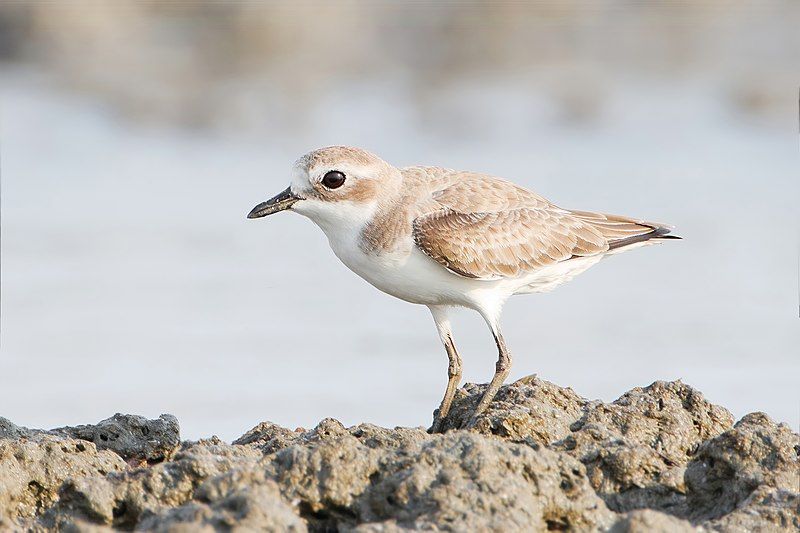
The Siberian sand plover is a species of bird that belongs to the plover family, including lapwings and dotterels. It is a small wading bird, found mainly in eastern Asia and the Himalayas.
It has a distinctive white belly and grey back, with a white wing bar and black tail feathers. The International Ornithologists’ Union (IOU) recently classified the Siberian sand plover as distinct from the lesser sand plover.
This was based on genetic and morphological studies, showing that the two species had evolved separately. As a result of this new classification, the IOU also changed the vernacular name of the Tibetan sand plover to the Siberian sand plover.
The Siberian sand plover is an essential species for conservation, as it is listed as Near Threatened on the IUCN Red List. It is threatened by habitat destruction, hunting, and climate change, leading to decreased population.
The species is also at risk from predation by local birds of prey and illegal collecting for the pet trade. By protecting the Siberian sand plover, we can help to ensure its future survival.
| Kingdom | Animalia |
| Phylum | Chordata |
| Class | Aves |
| Order | Charadriiformes |
| Family | Charadriidae |
| Genus | Charadrius |
| Species | C. mongolus |
8. Great Hornbill
The great hornbill is a large bird belonging to the hornbill family. Other names, such as the concave-casqued hornbill, great Indian hornbill, and great pied hornbill, also know it. It can be found in the Indian subcontinent and Southeast Asia.
The great hornbill has a mainly frugivorous diet, meaning its primary food source is fruits. However, it also preys on smaller animals such as mammals, reptiles, and other birds. It is an omnivorous species that can feed on plants and animals.
The great hornbill is a majestic bird with distinctive features such as its large yellow and black curved beak and casque. It is an essential species for local ecosystems, as it helps maintain the balance between predators and prey.
It is also famous among bird watchers due to its unique physical features and prevalence in certain regions.
| Kingdom | Animalia |
| Phylum | Chordata |
| Class | Aves |
| Order | Bucerotiformes |
| Family | Bucerotidae |
| Genus | Buceros |
| Species | B. bicornis |
9. Oriental Darter
The Oriental darter is an aquatic bird native to tropical regions of South Asia and Southeast Asia. Its most distinctive feature is its long, slender neck, which is topped by a sharp, straight bill.
This bill is designed for hunting fish, and the bird can do this while almost completely submerged in water. This behavior is very similar to that of a cormorant, another type of bird.
While submerged, the Oriental darter uses its bill to scan the water and catch any fish it finds. It can also store the fish in its throat pouch, allowing it to swallow the fish underwater.
This fantastic adaptation allows the Oriental darter to be an effective predator in its aquatic environment.
| Kingdom | Animalia |
| Phylum | Chordata |
| Class | Aves |
| Order | Suliformes |
| Family | Anhingidae |
| Genus | Anhinga |
| Species | A. melanogaster |
10. Blue Breasted Quail
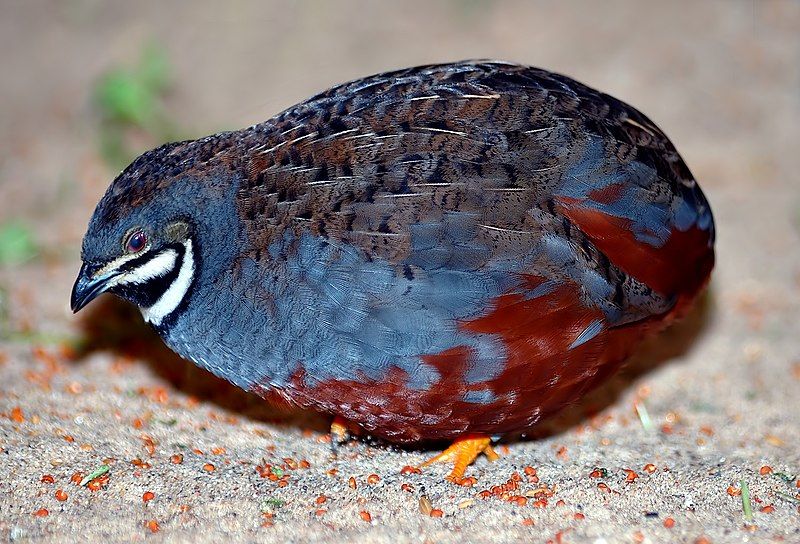
The king quail is a species of Old World quail that belongs to the Phasianidae family. It is also known by other names such as the blue-breasted quail, Asian blue quail, Chinese painted quail, and Chung-Chi.
The king quail is native to much of Southeast Asia and parts of India, China, and the Philippines. The king quail is a small bird, typically around 13 cm long. Its body is covered in brown feathers, with a distinctive blue patch on its breast.
These birds are also known for their vibrant colors, with some varieties having purple heads, yellow wings, and red legs. In the wild, the king quail feeds on insects, seeds, and other small invertebrates.
They are ground-dwelling birds and prefer to stay near the ground for food.
These birds also love dust baths, as they often roll around in the dirt and leaves to keep themselves clean. The king quail is a famous bird in the pet trade and aviculture.
They are relatively easy to care for, and many people keep them as pets in cages, aviaries, or even in free-range settings. They are also popular as exhibition birds due to their attractive colors and easy-going demeanor.
| Kingdom | Animalia |
| Phylum | Chordata |
| Class | Aves |
| Order | Galliformes |
| Family | Phasianidae |
| Genus | Synoicus |
| Species | S. chinensis |
11. Chestnut-winged Cuckoo
The chestnut-winged cuckoo, also known as the red-winged crested cuckoo, is a bird found in Southeast Asia and parts of South Asia. It is a striking bird with dark glossy upperparts, a black head, and a long crest.
It has chestnut-colored wings and a long, glossy, graduated black tail. Its throat and underside are rufous in color, and it has a distinctive white half-collar around its neck. It is a medium-sized bird with a length of 28–32 cm.
It has a broad wingspan and can be found in a variety of habitats, ranging from open woodlands to scrublands. It is an omnivorous species, feeding insects, fruit, and small reptiles.
It is considered an important species in its native range, as it helps to control the population of insect pests.
| Kingdom | Animalia |
| Phylum | Chordata |
| Class | Aves |
| Order | Cuculiformes |
| Family | Cuculidae |
| Genus | Clamator |
| Species | C. coromandus |
12. Bronze-winged Jacana
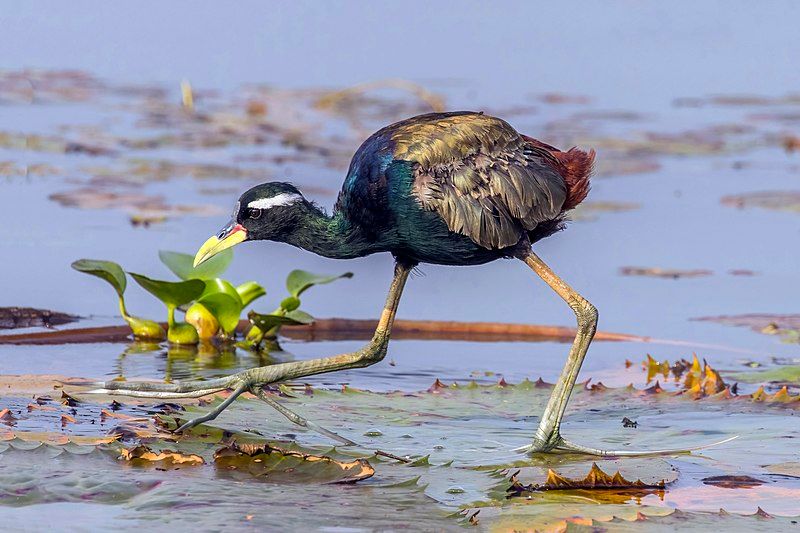
The bronze-winged jacana is a species of wader in South and Southeast Asia. It is part of the Jacanidae family and is the only species in the genus Metopidius.
Jacanas are unique in that their long feet allow them to spread their weight over the surface of the water, enabling them to walk on floating vegetation such as lilies. This adaptation allows them to feed on aquatic vegetation without sinking.
The bronze-winged jacana is specially adapted to this lifestyle, allowing it to thrive in a variety of aquatic habitats across its range. Its long feet help it to balance on floating vegetation, and its beak is specially adapted for probing the water for food.
These adaptations have allowed the bronze-winged jacana to become a successful and widespread species in its native range.
| Kingdom | Animalia |
| Phylum | Chordata |
| Class | Aves |
| Order | Charadriiformes |
| Family | Jacanidae |
| Genus | Metopidius |
| Species | M. indicus |
13. White-browed Crake
The white-browed crake is a species of bird belonging to the family Rallidae.
It is native to several countries throughout Asia and Oceania, including Australia, Brunei, Cambodia, Fiji, Hong Kong, Indonesia, Japan, India, Malaysia, Micronesia, New Caledonia, Palau, Papua New Guinea, the Philippines, Samoa, Singapore, Solomon Islands, Thailand, and Vanuatu.
This species of bird is primarily found in wetland habitats such as marshes, swamps, and wet grasslands, although it may occasionally inhabit other areas such as mangroves, forests, and agricultural fields.
The white-browed crake is a small bird, typically measuring 14-17 cm long and weighing around 40-60 grams. It has a distinctive white eyebrow, which gives it its name. Its upperparts are mainly brown, while its underparts are greyish-white.
It has a short, black bill, short wings, and long legs. Its tail is long and pointed. The white-browed crake mainly feeds on small invertebrates such as worms, snails, and insects. It is generally solitary, although pairs may sometimes be seen in the breeding season.
Breeding usually takes place between July and October, with the female laying a clutch of 3-4 eggs in a nest built on the ground. The eggs are incubated for around 17 days, and the chicks fledge after another 17 days.
The chicks are then cared for by both parents, although the female takes on most of the responsibility for caring for the young. The white-browed crake is considered to be a common species, although its population is believed to be declining in some areas due to habitat loss.
It is therefore listed as Least Concern by the IUCN Red List of Threatened Species. However, conservation efforts are necessary in order to ensure that the population of this species remains stable in the future.
| Kingdom | Animalia |
| Phylum | Chordata |
| Class | Aves |
| Order | Gruiformes |
| Family | Rallidae |
| Genus | Poliolimnas |
| Species | P. cinereus |
14. Indian Spot-billed Duck
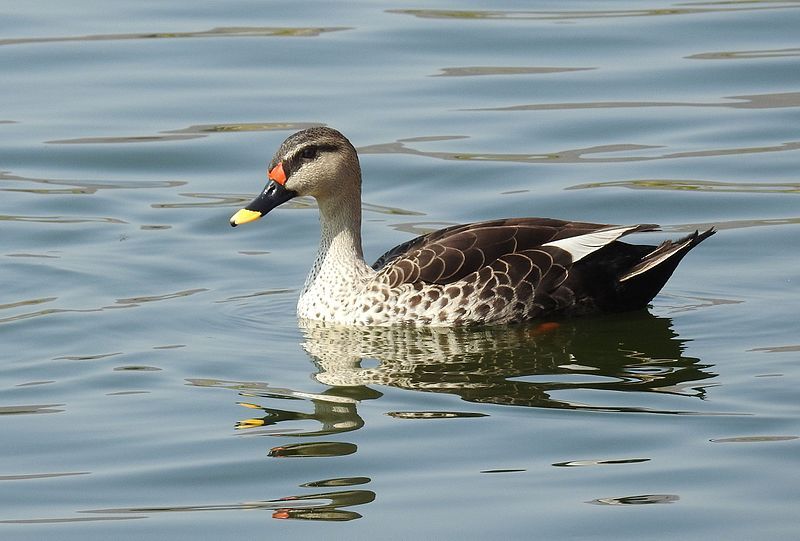
The Indian spot-billed duck is a species of large dabbling duck found around freshwater wetlands in the Indian subcontinent. It is a non-migratory breeding duck, meaning that it does not travel long distances and instead remains in the same area for the majority of its lifespan.
This species gets its name from the red spot that can be seen at the base of its bill, which is only present in the mainland Indian population. The spot-billed duck is a large bird, with a wingspan that ranges from 48 to 60 cm.
It is mainly brown in color with a black and white head and a white underbelly. The male and female of this species look similar and are difficult to tell apart. It feeds mainly on seeds, aquatic vegetation, and small insects.
The Indian spot-billed duck is listed as a species of Least Concern by the IUCN and is not considered to be at risk of extinction.
| Kingdom | Animalia |
| Phylum | Chordata |
| Class | Aves |
| Order | Anseriformes |
| Family | Anatidae |
| Genus | Anas |
| Species | A. poecilorhyncha |
15. Black-crowned Night Heron
The black-crowned night heron (also known as the black-capped night heron) is a medium-sized heron found on every continent except Antarctica. It is often referred to as just the night heron in Eurasia.
This heron is widespread and can be found in many different parts of Europe, Asia, North America, and South America. The black-crowned night heron is easily recognizable by its dark grey plumage and black crown, which contrasts with its white face and throat.
It has a stocky body and long yellow legs. This heron typically feeds on small fish, frogs, insects, and crustaceans. They forage in shallow waters and are most active at night. The black-crowned night heron can typically be found near wetlands, rivers, and lakes.
They breed in colonies and build nests in trees or shrubs.
These birds are also highly migratory and will travel long distances in search of food. The black-crowned night heron is an important species for many ecosystems, as it helps to keep populations of aquatic creatures in balance.
Therefore, it is essential to protect this species and its habitats in order to ensure its continued existence.
| Kingdom | Animalia |
| Phylum | Chordata |
| Class | Aves |
| Order | Pelecaniformes |
| Family | Ardeidae |
| Genus | Nycticorax |
| Species | N. nycticorax |
16. Javan Pond Heron
The Javan pond heron is a species of wading bird found throughout Southeast Asia. It belongs to the heron family and has a distinctive appearance, making it easy to identify. It has a white body, with white wings, a yellow bill with a black tip, yellow eyes, and yellow legs.
It measures approximately 45 cm in length, making it an average-sized heron. The Javan pond heron’s diet consists mainly of insects, fish, and crabs, which it obtains from shallow wetlands such as fresh and salt-water wetlands.
The bird spends most of its time scanning the water for prey. It has an efficient hunting technique and is capable of locating prey in murky waters. The Javan pond heron is a solitary creature and is rarely seen in large groups.
It is not migratory and is usually found in the same area year-round. It is also a noisy bird, making loud calls when disturbed or when searching for food. The Javan pond heron is an integral part of Southeast Asia’s biodiversity.
It plays a vital role in the local environment, helping to regulate wetland ecosystems and providing food for other creatures. It is also a popular bird to observe for birdwatchers and photographers.
Unfortunately, habitat destruction and pollution are putting the species at risk of extinction. It is now considered an endangered species and conservation efforts are needed to protect the future of this beautiful bird.
| Kingdom | Animalia |
| Phylum | Chordata |
| Class | Aves |
| Order | Pelecaniformes |
| Family | Ardeidae |
| Genus | Ardeola |
| Species | A. speciosa |
17. Indian Cormorant
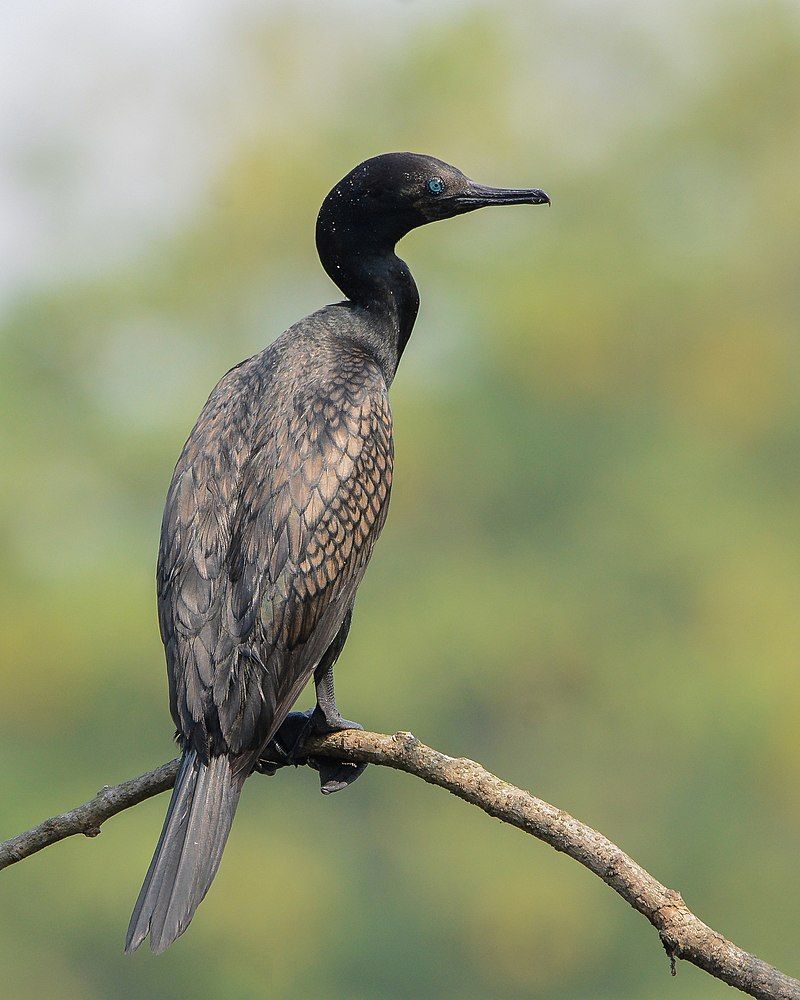
The Indian Cormorant, also known as the Indian shag, is a species of bird belonging to the cormorant family. It is found across the Indian Subcontinent, living mainly along the inland waters and coastal areas.
The range of the Indian Cormorant stretches from the west coast of Sind across India up to the eastern countries of Thailand and Cambodia. The Indian Cormorant is a large bird, about the size of a large duck. It has a long neck, hooked bill, and webbed feet.
It is speckled brown and black in color with a white patch around its neck. The bird is mainly found near freshwater bodies like lakes, rivers, and ponds. The Indian Cormorant feeds primarily on fish, which it catches by diving underwater and swallowing its prey.
Its diet also includes amphibians, crustaceans, and other small aquatic animals.
It is an expert fisher, able to dive as deep as ten meters underwater and stay submerged for up to a minute. The Indian Cormorant is an integral part of the aquatic ecosystem of the Indian Subcontinent.
It helps keep the waterway free of fish, thus maintaining a healthy balance of the fish population in the area. Additionally, by preying on amphibians and crustaceans, it also helps to keep the water clean. The Indian Cormorant is a threatened species due to a variety of factors.
These include habitat destruction, pollution, and overfishing. As a result, conservation efforts are being made to protect the species and its habitat.
| Kingdom | Animalia |
| Phylum | Chordata |
| Class | Aves |
| Order | Suliformes |
| Family | Phalacrocoracidae |
| Genus | Phalacrocorax |
| Species | P. fuscicollis |
Conclusion
Nakhon Nayok is a fantastic place to observe a variety of bird species. The diverse habitats found in the area create an ideal environment for many species of birds to thrive.
The abundance of food sources, such as insects, fruits, and seeds, make it an excellent spot for birdwatchers to spot birds of all types. Furthermore, the protected areas in the region provide a safe haven for many of the endangered species of birds.
Nakhon Nayok is a great place to explore and observe the fantastic world of birds.